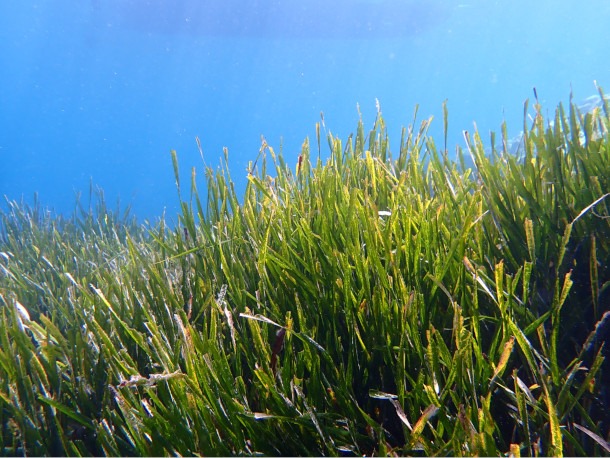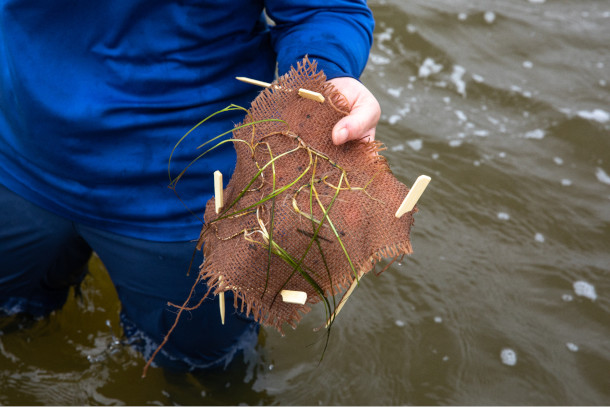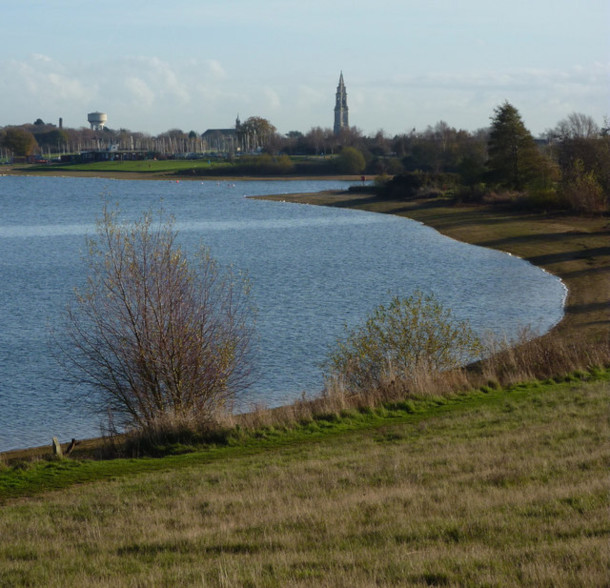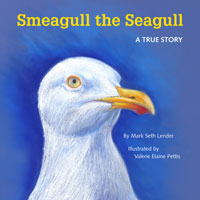Seagrass "Gardening"
Air Date: Week of May 23, 2025

Seagrass is a hidden gem responsible for large quantities of carbon absorption and fish production. (Photo: Frédéric Ducarme, Wikipedia Commons, CC BY-SA 4.0)
Seagrass is a foundation of marine ecosystems and stores as much as 35 times more carbon than a tropical rainforest, but warming ocean temperatures and other threats are wiping seagrass out. There is hope, though, as a project to “garden” or cultivate more resilient varieties is making waves along the U.S. East Coast. Hosts Aynsley O’Neill and Jenni Doering chat about the benefits and promising results of this seagrass “gardening.”
Transcript
O’NEILL: Well, Jenni, speaking of marine protected areas and seagrass, I think we ought to take a second to highlight just how cool this plant really is.
DOERING: Oh yeah, I mean for one it captures a lot of carbon, doesn’t it?
O’NEILL: Yes it does. I learned about this from Boze Hancock who is a marine restoration scientist with The Nature Conservancy and he explained to me that this is more than just seagrass using carbon dioxide to grow, like all plants do. It also slows down water flow, which allows the organic matter of the world to settle and accumulate on the ocean floor.
HANCOCK: Over time, there's a lot of material that gets buried because it's being caught by the seagrass bed and that contains a lot of carbon. So that's where your carbon sequestration comes from.
O’NEILL: And you might be surprised by just how much carbon this actually stores. We’re talking up to 35 times more carbon than tropical rainforests can store in the same period! Tropical rainforests!
DOERING: Wait a minute, seriously? I had no idea seagrass could have like THAT big of an impact on the carbon balance of the Earth.
O’NEILL: Right? I genuinely never would have guessed, and that’s why I was really glad to get this sort of lowdown from Boze Hancock. Balancing atmospheric carbon is only one part of the story. Seagrass is also a vital part of the near-shore ecosystem. So, kind of like the trees in a forest, it’s the structure that defines the entire ecosystem.
HANCOCK: That structure is what the fish need, what the small invertebrates need, what the food chain requires. It's why seagrass is one of our fish producing factories. Seagrass makes a lot of new fish for the environment, basically because the babies have somewhere to hide. So if you're a baby fish and you find a seagrass bed, you've actually found a nice safe house with a really well stocked fridge, and that bottom of the food chain then flows out through the fish, through the baby stages, into the larger fish and on.
DOERING: Aw, now I’m picturing little baby fish hiding in the seagrass just like Nemo in the amenomenome….
O’NEILL: Amnemmonemonene. An… anemonem… monemone! [AD LIB THIS]
It’s definitely pretty cute to think about. But sadly Jenni, as with so many of our stories, now we pivot. These baby fish and the seagrass are in hot water, though, because our greenhouse gas emissions are warming the planet. And you know the oceans have taken up a lot of that extra heat – as much as 90 percent! Boze told me that some spots close to home have it especially bad.

By placing plots of seagrass in warmer locations, scientists are figuring out which varieties can adapt to a changing environment. (Photo: NASA Kennedy Space Center, Wikimedia Commons, Public Domain)
HANCOCK: In the Atlantic coast, particularly New England, temperatures are going up faster than they are on average, around the rest of the world. Our sea temperatures are going up nearly twice as fast as the average. So we've really seen an impact of increasing water temperatures in the near shore, and we're getting to the point now where we've reached the thermal limit for seagrass.
DOERING: Oh man. Much as I’d like warmer water for swimming, that doesn’t sound good.
O’NEILL: Definitely not, and it’s not just the heat that poses a threat – fertilizer runoff and ship anchors can hurt seagrass, too.
DOERING: Oh yeah. And you know, Carlos Molina, the Goldman Prize winner we just heard from, he also briefly touched on the fact that seagrass is very vulnerable to things like port construction. So given how important seagrass is, what’s to be done about all these threats?
O’NEILL: Well, were pivoting right back to the good-news part of this story. Boze Hancock and the team at the Nature Conservancy have this really cool project that they call “seagrass gardening.”
DOERING: Huh ok. Wait a minute, you’re not saying I can grow seagrass next to my tomatoes and garlic…
O’NEILL: Haha, Jenni I know you have a green thumb, but I’m not sure even you could pull that off. They call this the “common garden experiment” but I don’t believe your tomatoes and seagrasses have much in common. The idea is that we, as humans, can help cultivate seagrass just like a crop to help replace what’s being lost to ocean warming.

Rising sea temperatures are pushing seagrass further and further from the near shore. (Photo: Andrew Hill, Wikimedia Commons, CC BY-SA 2.0)
DOERING: Ok, so Aynsley, how does it work?
O’NEILL: Well, Jenni, as far as I can tell it takes a little more patience than waiting for zucchini to ripen. Granted, I’ve never waiting for zucchini to ripen other than in my fridge. But, I still think that it’s a little trickier because this is all trial and error. They take patches of seagrass from different regions and microclimates and they transport them to warmer waters to see which ones adapt and survive. And then they repeat that process over and over and over again.
DOERING: Huh! So it sounds like survival of the fittest. And I think scientists restoring corals are doing something similar. So what has all this careful selection led to?
O’NEILL: Well, Boze tells me that the more resilient types of seagrass, which are from slightly warmer regions, are really starting to take off when they’re planted in spots where the local seagrass has died off.
HANCOCK: There are some fantastic examples of where seagrass restoration has been spectacularly successful. The Virginia Coast reserve on the Atlantic side of the Delmarva Peninsula is probably the best seagrass restoration project on the planet at this point. We've gone from zero seagrass in that system of lagoons between the Delmarva Peninsula and the barrier islands to, last time I looked at it, we were over 10,000 acres. Really successful.
DOERING: Huh! I have to admit, I’m a little squeamish about seagrass tickling my feet when I’m swimming at the beach, but it does sounds like it’s something to celebrate!
O’NEILL: There is something to celebrate, so I vote that we push all that blame onto seaweed instead. It’s completely different but definitely still slimy. Because yes, the seagrass garden is a win for conservation! With the work that Boze Hancock and other scientists are doing to help these seagrasses thrive in a warming world, I have some hope that seagrass won’t be going anywhere anytime soon.
Links
Learn more about the link between seagrass and carbon emissions.
Living on Earth wants to hear from you!
Living on Earth
62 Calef Highway, Suite 212
Lee, NH 03861
Telephone: 617-287-4121
E-mail: comments@loe.org
Newsletter [Click here]
Donate to Living on Earth!
Living on Earth is an independent media program and relies entirely on contributions from listeners and institutions supporting public service. Please donate now to preserve an independent environmental voice.
NewsletterLiving on Earth offers a weekly delivery of the show's rundown to your mailbox. Sign up for our newsletter today!
 Sailors For The Sea: Be the change you want to sea.
Sailors For The Sea: Be the change you want to sea.
 The Grantham Foundation for the Protection of the Environment: Committed to protecting and improving the health of the global environment.
The Grantham Foundation for the Protection of the Environment: Committed to protecting and improving the health of the global environment.
 Contribute to Living on Earth and receive, as our gift to you, an archival print of one of Mark Seth Lender's extraordinary wildlife photographs. Follow the link to see Mark's current collection of photographs.
Contribute to Living on Earth and receive, as our gift to you, an archival print of one of Mark Seth Lender's extraordinary wildlife photographs. Follow the link to see Mark's current collection of photographs.
 Buy a signed copy of Mark Seth Lender's book Smeagull the Seagull & support Living on Earth
Buy a signed copy of Mark Seth Lender's book Smeagull the Seagull & support Living on Earth

